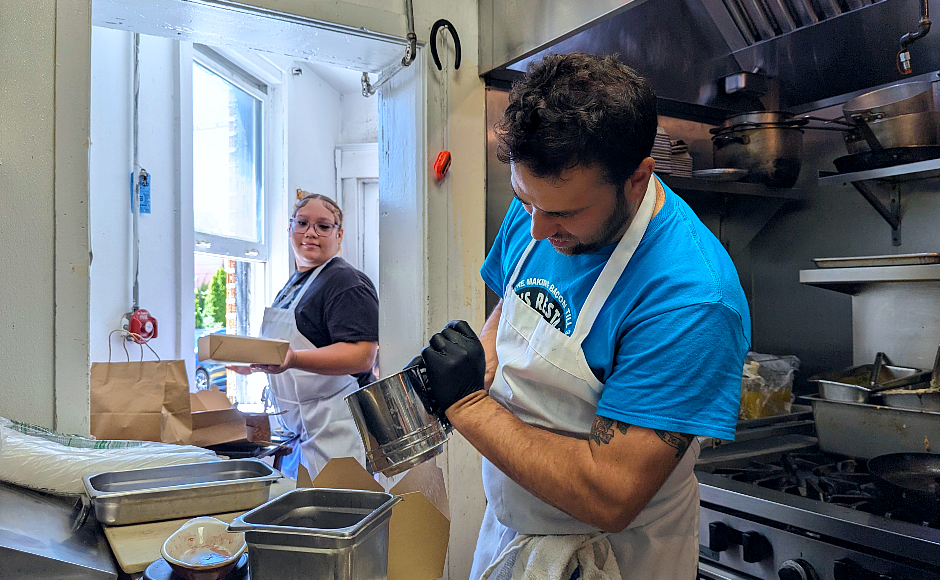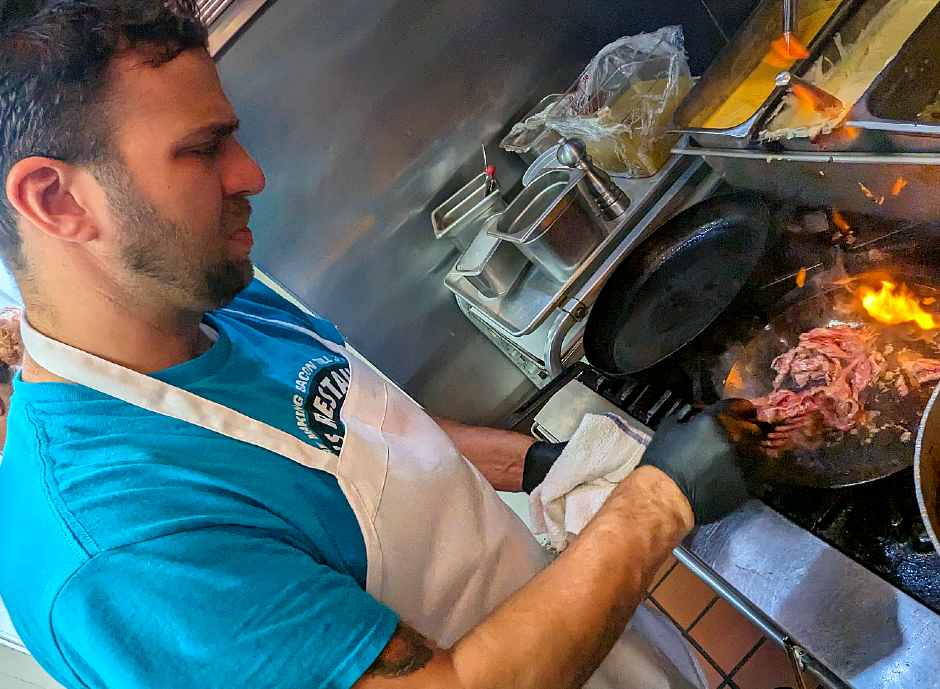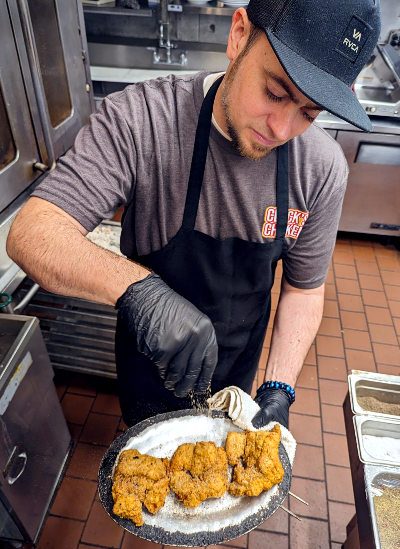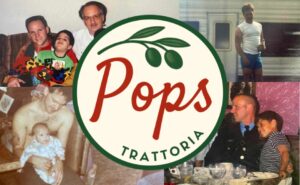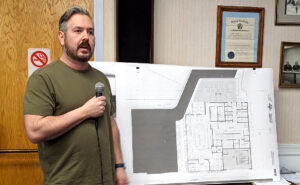During the COVID-19 pandemic, restaurateurs turned to innovative food service concepts to stay afloat. Now they’re revisiting those approaches to push back against rising costs and stay creatively sharp.
By Matt Skoufalos | June 24, 2024
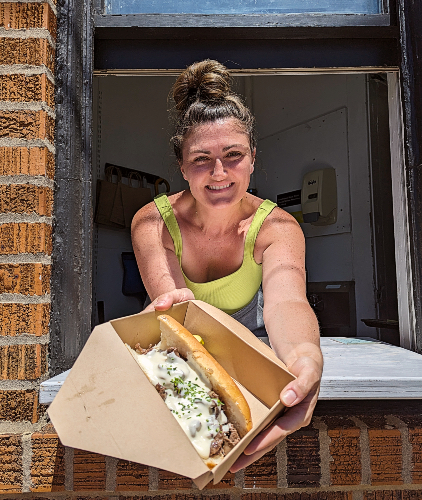
Christina Cusack shows off a wagyu beef cheesesteak at June BYOB in Collingswood. Credit: Matt Skoufalos.
Longevity in the restaurant industry is predicated upon sustaining excellence across a number of factors, including consistency, quality of service, and responsiveness to customer appetites.
Far less predictable are the hard numbers that can undercut achievements in those areas, like the cost of commercial rents, staffing, and the price of ingredients.
With the National Restaurant Association reporting wholesale food costs around 30 percent higher than they were before the novel coronavirus (COVID-19) pandemic, and trending up, some chef-driven restaurants are searching for other ways to add to their bottom lines.
In Collingswood, a pair of fine dining establishments have begun playing with pop-up menus, slinging to-go, off-menu dishes at the same storefronts in which they serve sit-down meals.
For Chef Richard Cusack of June BYOB, serving special menus out the side window of his Collingswood restaurant satisfies both a financial and emotional impulse.
Cusack feels like the exercise brings him closer to his patrons while also offering him a chance to take his menu in different directions.
“It’s more personal,” he said. “I like customers looking in and they can say, ‘Oh it’s the chef!’ It feels like South Philly with people popping in to say what’s up.
“It’s good for community and helping Collingswood,” Cusack said; “connecting with the customers and letting them know you’re there, and you’re humble.”
Compared to the time investment in crafting a fine dining dinner service, it’s also easier for the chef to draw up a special sandwich menu — like his wagyu beef cheesesteak, boeuf bourginon, or crab galette — and indulge his creativity for an afternoon.
“When customers come to dine at June, I sit down with a menu and the staff, and make sure everything’s presented expertly,” Cusack said.
“I always feel like I have to do something better, something over the top.
“This you don’t have to explain,” he said.
“A sandwich, I can do whatever I want.”
Christina Cusack, who handles the back end of the family business, said the freedom to offer different takeaway specials not only also helps make up for slow days during the week, but also invites new business.
“During COVID, when we had to sell out our window, [Richard] was able to do something different other than fine French dining,” Christina Cusack said.
“And people who want to try us out, but maybe not for fine dining, they’ll have a burger.”
Chef-in-training Makaiyah Johnston, who works as a window cashier for the June BYOB pop-ups, said she appreciates the customer interaction, too.
“The people out here ask questions,” Johnston said. “They’re so excited to come back again and taste the food. People love seeing his food no matter what it is.”
Just a few storefronts away, Nunzio’s by Chef Michael DeLone is leaning heavily into the speakeasy model, operating a ghost kitchen sandwich business, Cluck’s Chicken, from the back door of the restaurant.
DeLone, who had long contemplated starting a food truck to supplement his brick-and-mortar business, described the plan as an efficient way of leveraging the infrastructure into which he’s already invested.
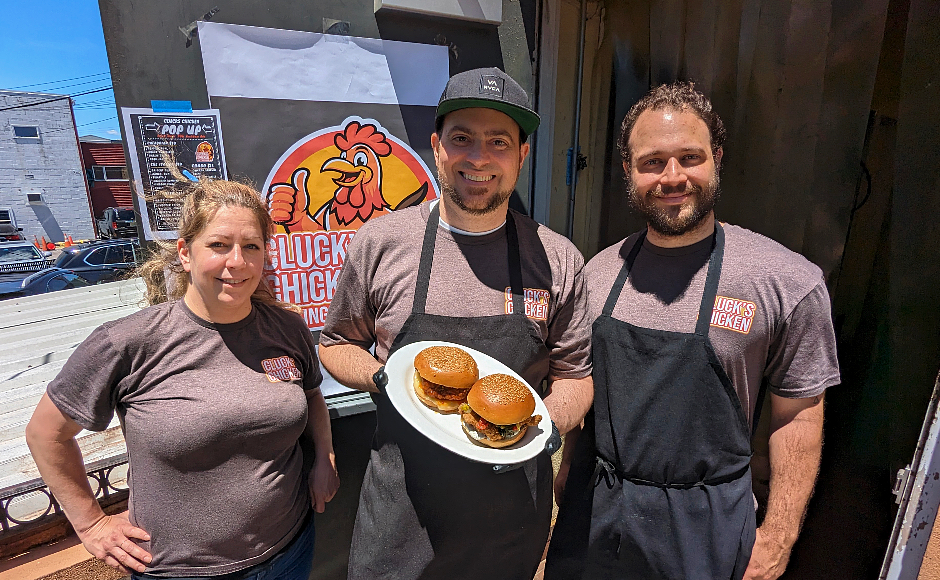
Chef Michael DeLone and crew at his Cluck’s Chicken speakeasy behind Nunzio’s by Chef Michael DeLone. Credit: Matt Skoufalos.
“You’re always looking for some extra revenue to bring in,” he said. “Obviously, BYOs and not being able to sell booze, every little bit counts; whether it’s $300 to $1,000, everything can go to something.
“It’s adapting to what’s around you; adapting to the demographic and what you see at your disposal when you’re not operating: the farmers market, how busy the street gets on Saturday and Sunday afternoons, and trying to hit every market that I can,” DeLone said.
“This is a good way to do that.”
DeLone debuted the recipes during the borough May Fair festival, and customer interest exceeded his expectations. He then experimented with the concept as a Saturday pop-up, serving sandwiches during the hours of the Collingswood Farmers Market.
Next, the business will spin off onto its own on Grubhub, Doordash, and Uber Eats from 3 to 8 p.m. Wednesday through Sunday — the five days a week that Nunzio’s is open.
Cluck’s Chicken is based upon the same principles that DeLone employs at Nunzio’s: sourcing fresh local ingredients and free-range chicken to create “something you can go back to and not feel bad about eating,” he said.
Sandwiches start at $10.
The chicken is salt-brined overnight, lightly seasoned, and dropped in buttermilk right before it hits the fryer.
Accompaniments include house-made potato chips and cinnamon-sugar zeppole.
DeLone, who has been open about the toll that running a restaurant takes on the mental health of a chef, said that the shift in mindset that he experiences running a sandwich pop-up or a ghost kitchen offers a different kind of excitement doing “fun food.”
“I was asked once, ‘If someone was to ask you what is the hardest part of your job that people don’t understand, what would you show them?’’ DeLone said.
“My response was, ‘the six hours of prep that goes into making your dinner,’” he said.
“The four hours of rolling out pasta; time that goes into every noodle and every ravioli that we put on your plate, those are the things that are masked.
“Understand how hard this is just to give you one plate; how much time goes into one plate,” the chef said.
“It’s fun for me to break that up; to get away from the tuna fois gras, and let them see you’re not a one-trick pony,” he said. “It’s changing that direction just enough to give you a new feeling.”
DeLone said the added opportunity of creating a menu specifically for Cluck’s Chicken also helps refresh his creativity for the dine-in experience at Nunzio’s. Like the Cusacks, he also believes that a well-crafted sandwich can become a gateway for new customers to sample his work.
“It’s filling a void; it’s using the building,” he said. “It makes sense for me to try whatever I can, and just keep pushing, coming up with fresh ideas.
“You can throw a stone around here and go get red sauce,” DeLone said. “But can you come in here and get clean Italian. Getting that out to people, and making them understand that just because this isn’t the traditional, this is what we do, and it’s still Italian, I think that that’s a big part of it.”
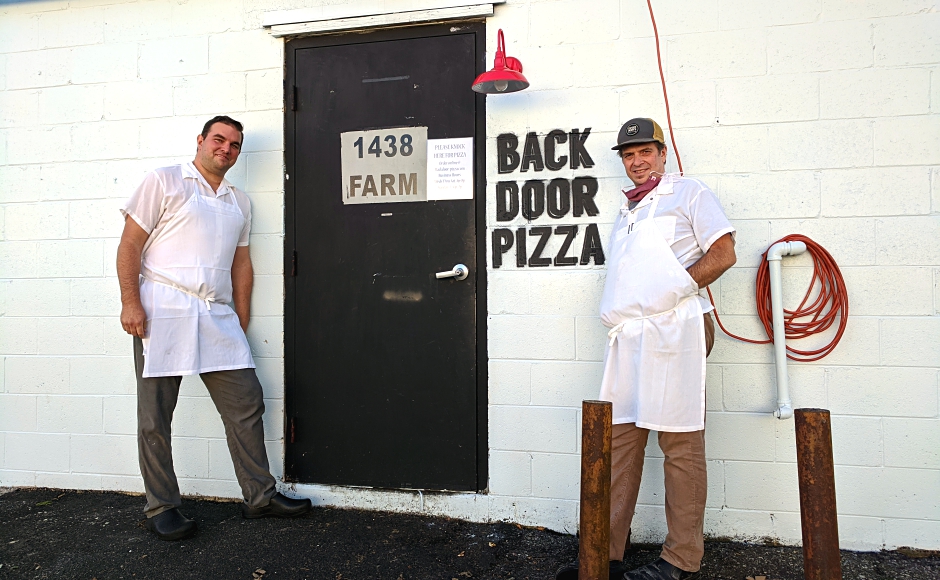
Farm and Fisherman Chefs Josh Lawler (left) and Todd Fuller at the entrance to Back Door Pizza in 2020. Credit: Matt Skoufalos.
During the novel coronavirus (COVID-19) pandemic, the Farm and Fisherman Tavern in Cherry Hill launched a speakeasy pizza concept, Back Door Pizza, as a way to overcome limits on indoor dining.
But almost five years later, long after the restrictions were discontinued, Back Door Pizza is still a strong supplement to the business.
“We never really thought that this would be a forever thing, but for us, we’ve worked out all the logistical problems, and we’re cool with it,” said Chef Todd Fuller.
“So many people find the allure of a hidden secret speakeasy situation, but if the pizza sucked, then it really wouldn’t be that fun,” he said.
Back Door Pizza was a mathematical exercise “predicated somewhat out of desperation,” Fuller said; a way to keep the business afloat while returning Farm and Fisherman staff to work during the pandemic.
Keeping it going during regular dinner service is akin to running a tightly choreographed stage production in a kitchen with limited clearance, he said.
“It’s quite an undertaking, but we’ve already worked that all out, so why would we stop this?” Fuller said.
“I do have faith in this as a concept if we ever wanted to spin it out somewhere else. Every problem we have is because we’re in a physically imposing space.”
For other chefs with a fine dining establishment and a bit of creativity, Fuller believes in the speakeasy, side-hustle model as a useful revenue-generator in an age of rising costs.
“If you have a kitchen that has the room to produce, then why not?” he said. “Any serious chef is always looking to expand their arsenal. We really rely on the quality of the product, and it works.”

